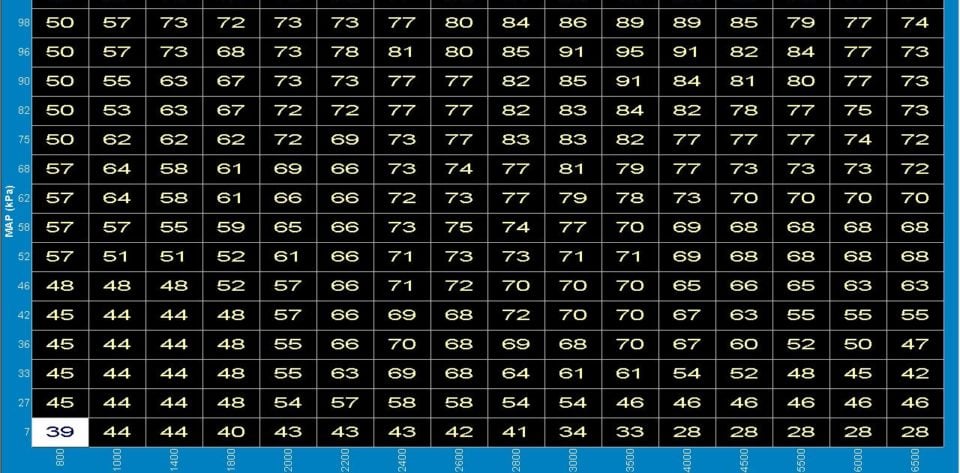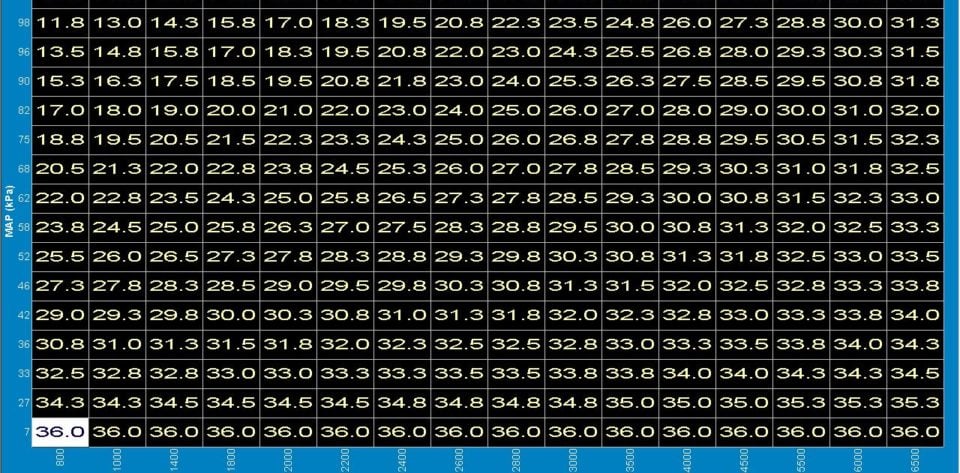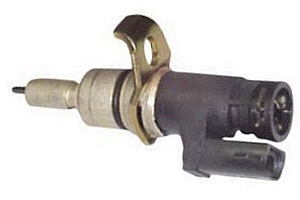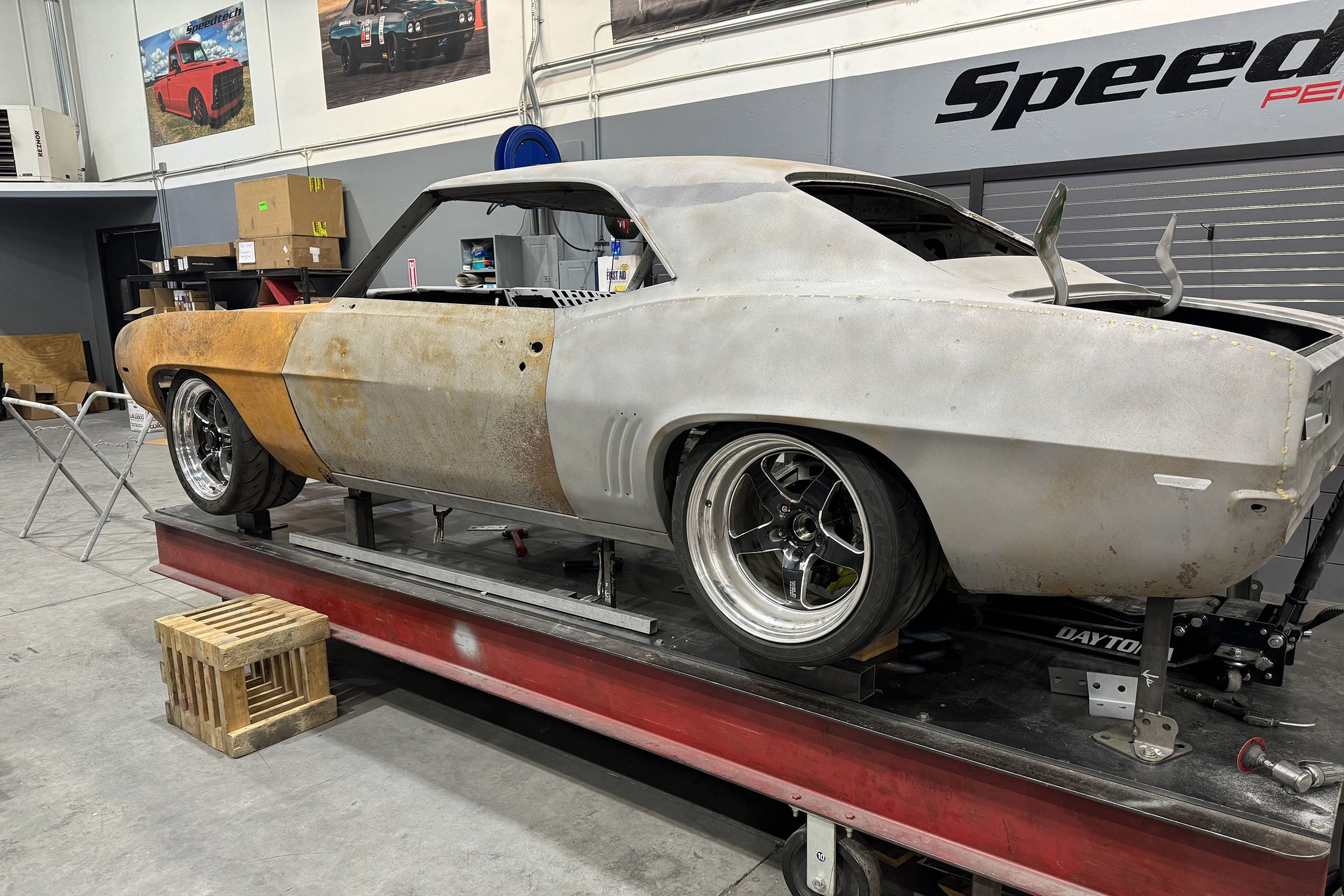Earlier this year, our good friends at FAST (Fuel Air Spark Technology) released the second rendition of their industry-renowned XFI Electronic Fuel Injection system, packed with several refined functions and capabilities found in the original XFI unit, along with a host of new features that bring even more control and adjustability for end users from the novice to professional tuners.
At the PRI Show in Orlando last winter, we had the opportunity to get a sneak peek at FAST’s XFI 2.0 and learn more about some of the features to expect, and now, with the LSX 388 engine build for our Drag Radial Camaro and utilizing the XFI 2.0 unit nearing completion, it’s time to take a closer look at FAST’s latest and greatest piece. In order to do so, we’ve sat down with:
• FAST’s own in house XFI technician Kevin Winstead
• Noted fuel injection tuning wizard and EFI University instructor Brian Macy
• Shawn Miller, the lead engine builder behind our LSX project at Virginia Speed
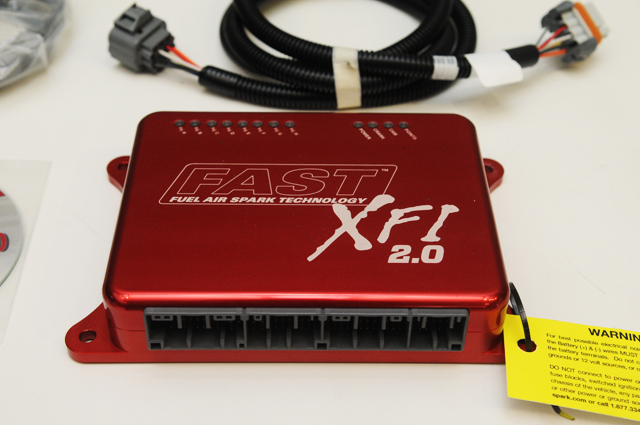
FAST's new XFI 2.0 EFI system offers several new and enhanced features, all of which begins with this new robust, aluminum enclosure.
The XFI 2.0 Hardware
The complete XFI 2.0 system is a combination of hardware and software that delivers revolutionary features and functions in one package, beginning with a rugged and stylish new billet enclosure to house the surface mount component circuit board. The XFI 2.0 system, like its predecessor, completely replaces the clunky factory computer and wiring harness that compromises performance. The latest built-in flash microprocessor technology provides lighting-quick processing speed, which FAST claims to be four times faster than earlier EFI systems. “The best way to explain the new XFI 2.0 hardware is that it’s robust,” explains Winstead. “The hardware itself found in both the XFI and XFI 2.0 is fairly new technology compared to our older FAST systems. Where some of those system were based more on OE design, these are all aftermarket.
The C-Com Software
On the software side of things, the Windows-based C-Com XFI application found in the original XFI system is once again in use in version 2.0, providing the ability to download the latest software and hardware firmware updates via email or the FAST website, all without ever physically removing the XFI 2.0 enclosure from the car.
But beyond those basics of the C-Com software are the essential tools that provide tuners the ability to adjust and fine-tune every element of the EFI system. Among those tools are several customizable tables for adjusting things, such as Idle Speed vs. Coolant Temperature and the Fuel Ratio vs. RPM & MAP (manifold absolute pressure), along with an incredibly useful set of 3D graphs that display the information in a form that the tuner can easily visualize their tune settings performed in the aforementioned tables.
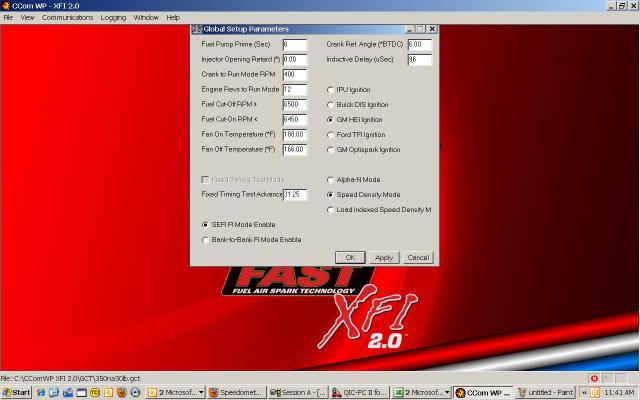
FAST's C-Com software, found in the original XFI system, is back - providing hardware and software updates, along with all of the tuning features necessary for operation of the XFI 2.0 system.
The Self Learning feature actually works really well, even on complex engine configurations. – Brian Macy
The self learning functionality new to the XFI 2.0 is certainly at the top of the list of impressive new features and one that will appeal to and make the transition to an aftermarket EFI system much simpler for novice users. “The Self Learning feature actually works really well, even on complex engine configurations” assures Macy.
The Self Learning VE table works by looking at your target air/fuel table and your base VE table and comparing the two, creating an automated VE map for your vehicle. Through the use of a dyno or normal street driving and with a wideband oxygen sensor and closed loop tuning, a ballpark fuel table can be created in short order. This obviously isn’t meant to nor can replace human input, but it will certainly get you a base to tune from. And for those jumping from the street to the strip and back, this is a great tool.
“I was a little skeptical at first when we were doing beta testing with the software,” explains Macy. “I had a $30,000 engine on the dyno that I was tuning, and I got it dialed in and then threw all the numbers off about 10% and ran the engine up. We could watch it actually see the air/fuel ratio and change the numbers back to what it should’ve been. In the end, it got really, really close to what I had. It wasn’t exact, but it was within a number or two.”
Tuning Basics
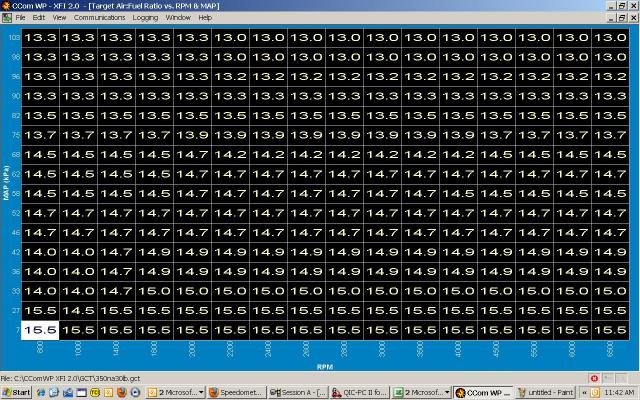
As you'd learn in any Tuning 101 course, Air to Fuel Ratio is one of your primary tuning variables; as seen in the Fuel Ratio vs. RPM & MAP C-Com table above.
I was a little skeptical at first when we were beta testing the self learning software, but in the end, it got really, really close to what I had. – Brian Macy
Macy, as instructor of the EFI University course and widely considered a guru of the FAST XFI system, is a leading authority on the topic of tuning; and as he instructs during his high-tech lectures, tuning with the XFI 2.0 and C-Com software begins with the ‘big three’ tables: the fuel, spark, and air/fuel tables, “Once you’ve got those tuned well, the car should run pretty well. Everything else that the ECU does is a modifier to those three tables. So until those three tables are tuned correctly, you really shouldn’t be moving on to anything else.”
When you get into the fuel table, you’ll find a 3D display table that allows you to visually see your mistakes or spikes in the fuel curve. As you navigate through, you can watch your settings as a moving dot in real-time and make changes based on your your target and actual air/fuel ratio – adding or subtracting fuel as you go to get the tune when it needs to be.
For those desiring a set amount of fuel delivery or timing at the starting line, the ability to use a fixed VE table. With either the clutch or transbrake engaged, a targeted fuel or timing number can be used to attain a specific air/fuel ratio. Than once you released the transbrake or clutch, the EFI system will revert back to the normal VE table.
Virtually every variable that one can adjust to dial-in their engine combination has it’s own specific table that can be infinitely adjusted, including tables to finely tune the Spark versus RPM, MAP versus RPM, MAP or Barometric Pressure versus RPM, with air, fuel, and timing adjustable based on the load setting you desire. Other elements such as the Coolant Temperature, Air Temperature Fueling, Timing, Target Air/Fuel Ratio versus Coolant Temperature, and a myriad of other tables are all in the software, providing limitless tuning ability for any applications or situation.
On the left is C'Com's Volumetric Efficency vs. RPM & MAP table, while the Spark Advance vs. RPM & MAP table can be seen on the right. While experienced tuners will generally start these tables from scratch, novice tuners can select from base tunes similar to their combination and adjust from those parameters.
When first installing the FAST XFI system, you’ll essentially have a blank slate on the tuning of your vehicle. For the advanced tuners out there, like Macy and Miller, this is where they’ll work their magic like an artist taking a brush to a fresh canvas. For the novice tuners among us, however, FAST offers a library of tunes covering a wide range of engines and fuel system setups that will provide an acceptable starting point for many cars. “It comes with a tune in the software, but it’s pretty generic,” explains Winstead. “It’s not really set up for anything in particular. You have to go in and fill out the size of the engine, MAP sensor, the size of the injectors, firing order, set up your RPM points, and things like that to really get it dialed in for a solid start.”
The 3D graphs in the C-Com software, which exist not to tune from but to provide a great visual look at your engine’s performance, allows for the ability to view in real time while the engine is running through it’s RPM range all of the variables and sensors controlled of read by the FAST XFI unit and software. On our LSX 388 project underway at Virginia Speed, Miller has installed two AEM four channel widebands, so there is an O2 sensor in each cylinder, which was actually plugged into the analog input on the FAST XFI 2.0, allowing for the recording of the data to the box.
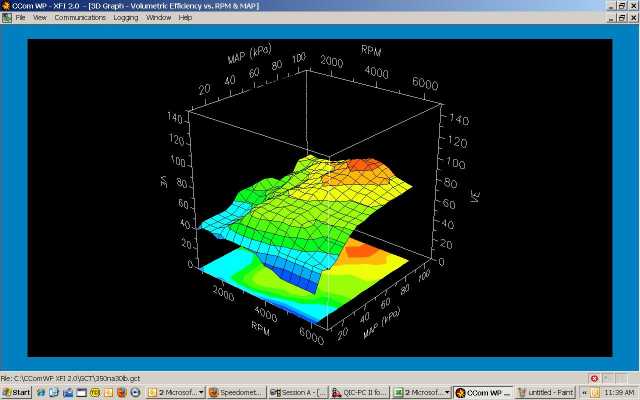
These 3D graphs within C-Com display the parameters of a specific table in a more visual way. Shown here is the Volumetric Efficiency vs. RPM & MAP, for which the table was shown above.
“This allowed us to look at all eight O2 sensors on the same screen with everything else that we were looking at as far as the engine data,” explains Miller. “I really like that feature, because normally you’d need to have separate screens for the wideband data and then your separate data log from the engine ECU, but when we were able to put those together, it just makes tuning it so much easier; being able to see what’s going on. That’s definitely one of the big pluses to the additional inputs in the new FAST box.”
Qwik Tune
The Qwik Tune Technology, new to the software designed for the XFI 2.0, allows for the use of four pre-programmed EFI MAP’s – or tunes – to be selected and engaged at the flick of a switch. So, say you’re driving your car a good distance to the track, and then plan on making several all-out quarter mile passes. Well, you want your cake and you want to eat it too, right? Meaning, you want the utmost in fuel mileage on the trip to and from, while wringing every drop of performance as possible out of your machine when you roll into the waterbox. Accomplishing this necessitates two quite different tunes. Says Winstead, “You could have a tune stored in this thing that’s race-only that requires a lot of fuel and really high ignition timing, and another that’s a ‘valet mode’ of sorts that reduces timing and the rev limiter, so it’s just a great tool to have.”
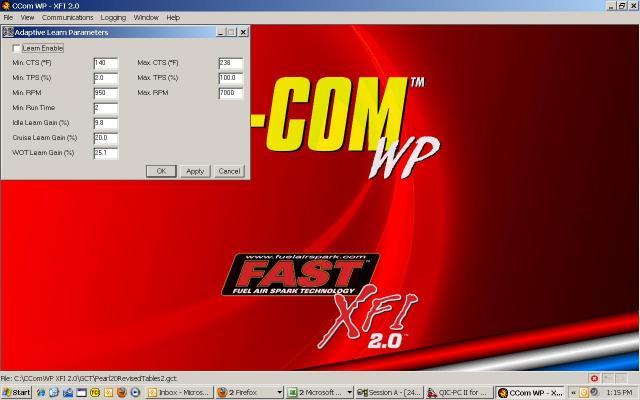
Along with the Adaptive Learning feature, the XFI 2.0 sports Qwik Tune, which allows four pre-programmed EFI MAP's - or tunes - to be selected and engaged at the flick of a switch in varying driving conditions.
Intelligent Traction Control is implemented through the ignition based on wheel speed through the use of a driveshaft collar or your vehicle speed sensor – if equipped with an electronic transmission – and is implemented through either timing or the rev limiter.
Intelligent Traction Control
With electronic fuel injection technology capable of providing a world of advanced features, traction control has become more commonplace in street and strip vehicles. And as an optional feature, the XFI 2.0 can deliver Intelligent Traction Control, solving the age-old problem of lost traction when attempting to put down a little power than your local strip or stoplight can handle.
The XFI 2.0 Intelligent Traction Control utilizes a predictive software that works in tandem with the hardware to keep your tires planted to the pavement by effectively reducing the horsepower through timing, the fuel curve, and other measures. And those who have experience with such systems aren’t perfect, they’re certainly a great tool to have at your disposal.
The traction control implementation in the XFI 2.0 features a Heuristic Mode, which means it’s running at all times, or it can be used selectively.
“Say you’re going to be doing some heads-up or bracket racing and the track is real greasy, it would be beneficial to do something like this and work with the traction control and allow it to help you,” says Winstead. “You can think of the traction control as a safety net, if you will, where if the car spins the tires off the line, it might save you. You’re not going to turn your quickest elapsed time because it’s got to reduce the power to maintain traction and then re-apply it.”
The traction control will work through the ignition based on wheel speed through the use of a driveshaft collar or your vehicle speed sensor – if equipped with an electronic transmission – and is implemented through either timing or the rev limiter. “The timing anticipates wheel spin and if it sees that, it’ll start pulling timing out to try and stop it,” explained Winstead. “If you actually exceed the driveshaft curve, it’ll start cutting cylinders. And the further you exceed it, the more cylinders it’ll cut, until the point that it’ll actually shut the engine off if you far exceed the driveshaft curve from tire spin.”
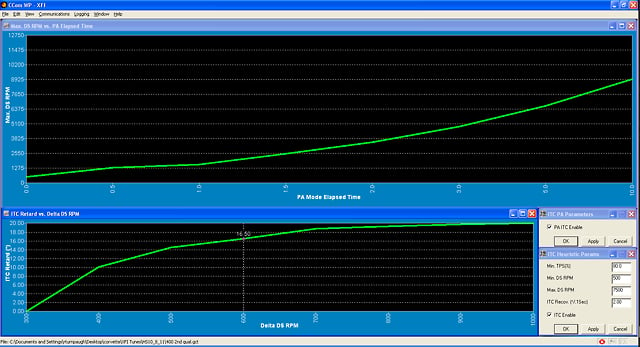
Traction control utilizes a predictive software that works in tandem with the hardware to keep your tires planted to the pavement by effectively reducing the horsepower through timing, the fuel curve, and other measures. The Traction Control curve can be seen here, where Driveshaft RPM, Timing Retard, and other factors are recorded.
Time-Based Boost and Power Adder Controls
Turbocharger and nitrous oxide users will also greatly appreciate new features that are part of the XFI 2.0 upgrade that cater to their applications, including a time-based boost controller that adds a whole new level of control, including two closed loop approaches. Included in the system is an XFI Boost Table settings chart to help determine their wastegate pressure figure to enter into the table per their boost setting requirements.
“When you’re on the trasnbrake or the clutch on the starting line at the dragstrip, the ECU knows through the use of a timer activated by the launch to utilize a boost control curve that you can use to tell it how much boost you want and how quick you want it to happen,” Macy explains. “This is above and beyond what your waste gate spring is, so if you wastegate spring is 10-pounds, then you’re not going to get less than 10-pounds. But you can certainly get more.”

Our XFI 2.0 EFI system, mated with MSD's Power Grid ignition system and AEM's 4-Channel Wideband controller.
The XFI 2.0 system also delivers a new progressive power adder control for nitrous oxide – both of the wet and dry variety. The system uses pulse width modulation to bring your nitrous kit or kits in progressively, and fuel and nitrous controls allow for the fine tuning of your nitrous system right to your fingertips.
Compatibility
The XFI 2.0 system, as Winstead explains, “is compatible with most intakes and throttle body systems.” FAST has options for cars utilizing 2, 4, 8, and even 16 injectors, and also six-cylinder and V10 applications. The unit can also drive high impedance or low impedance injectors.
How Do The XFI And XFI 2.0 Differ?
- XFI 2.0 features a processor that’s four times faster than that in the “classic” XFI unit
- XFI 2.0 uses a 104-pin wire harness versus a 60-pin on the original
- Performance features like four stage power adder control, boost control, and traction control re now included the XFI 2.0 system, whereas they were separately purchased features with the “classic” unit. These features can be enabled through the software and run in batch fire or sequential mode.
Conclusion
The talented and forward-thinking group at FAST clearly have a winner with their new XFI 2.0 electronic fuel injection system, bringing some incredible new features to the table for tuning every variable that controls your vehicles fuel and timing system and then some, with added highlights including the Intelligent Traction Control, Boost and Power Adder Controls, and the Qwik Tune feature. But perhaps most importantly, they’ve delivered a unit that not only satisfies the high-maintenance demands of professional tuners, but comes with the novice or even the rookie tuner in mind, meaning FAST has a product on their hands that truly has every rank of tuner in mind.




